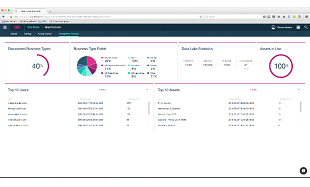BMC’s 2016 mainframe survey, covered by DancingDinosaur, both directly and indirectly pointed to increased activity in regard to data center applications. Mainly this took the form of increased interest in Java on the z as a platform for new applications. Specifically, 72 percent of overall respondents reported using Java today, while 88 percent reported plans to increase their use of Java. At the same time, the use of Linux on the z has been steadily growing year over year: 41 percent in 2014, 48 percent in 2015, 52 percent in 2016. This growth of both Linux and Java point to a heightened interest in application development, management, and change.

IBM’s Project DataWorks helps users access and gain insights from the 90 percent of unstructured data that goes untapped.
IBM has been feeding this kind of AppDev interest with its continued enhancement of Bluemix and the rollout of the Bluemix Garage method. More recently, it announced a partnership with Topcoder, a global software development community comprised of more than one million designers, developers, data scientists, and competitive programmers with the aim of stimulating developers looking to harness the power of Watson to create the next generation AI apps, APIs and solutions.
According to Forrester VP and Principal Analyst JP Gownder in the IBM announcement, by 2019 automation will change every job category by at least 25 percent. Additionally, IDC predicts that 75 percent of developer teams will include cognitive/AI functionality in one or more applications by 2018. The industry is driving toward a new level of computing potential not witnessed since the introduction of Big Data.
To further drive the cultivation of this new style of developer, IBM is encouraging participation in Topcoder-run hackathons and coding competitions. Here developers can easily access a range of Watson services—such as Conversation, Sentiment Analysis, or speech APIs—to build powerful new tools with the help of cognitive computing and artificial intelligence. Topcoder hosts 7,000 code challenges a year and has awarded $80 million to its community. In addition, developers will have the opportunity to showcase and monetize their solutions on the IBM Marketplace, while businesses will be able to access a new pipeline of talent experienced with Watson and AI.
In addition to a variety of academic partnerships, IBM recently announced the introduction of an AI Nano degree program with Udacity to help developers establish a foundational understanding of artificial intelligence. Plus, IBM offers the IBM Learning Lab that features more than 100 curated online courses and cognitive use cases from providers like Codecademy, Coursera, Big Data University, and Udacity. Don’t forget IBM developerWorks that offers how-to tutorials, and courses on IBM tools and open standard technologies for all phases of the app development lifecycle.
To keep the AI development push going, just last week IBM unveiled the experimental release of Project Intu, a new system-agnostic platform designed to enable embodied cognition. The new platform allows developers to embed Watson functions into various end-user device form factors, offering a next-generation architecture for building cognitive-enabled experiences.
Project Intu is accessible via the Watson Developer Cloud and is also available on Intu Gateway and GitHub. The initiative simplifies the process for developers wanting to create cognitive experiences in various form factors such as spaces, avatars, robots, or other IoT devices. In effect, it extends cognitive technology into the physical world. The platform enables devices to interact more naturally with users, triggering different emotions and behaviors and creating a more meaningful and immersive experience for users.
Developers can simplify and integrate Watson services such as Conversation, Language, and Visual Recognition with the capabilities of the device to act out the interaction with the user. Instead of a developer needing to program each individual movement of a device or avatar, Project Intu makes it easy to combine movements that are appropriate for performing specific tasks like assisting a customer in a retail setting, or greeting a visitor in a hotel in a way that is natural for the visitor.
Project Intu is changing how developers make architectural decisions about integrating different cognitive services into an end-user experience, such as what actions the systems will take and what will trigger a device’s particular functionality. Project Intu offers developers a ready-made environment on which to build cognitive experiences running on a wide variety of operating systems: from Raspberry PI to MacOS, Windows to Linux machines, to name a few. For example, IBM has worked with Nexmo, the Vonage API platform, to demonstrate the ways Intu can be integrated with both Watson and third-party APIs to bring an additional dimension to cognitive interactions via voice-enabled experiences using Nexmo’s Voice API’s support of WebSockets.
With initiatives like these, the growth of cognitive-enabled applications will likely accelerate. As IBM reports, IDC recently estimated that “by 2018, 75 percent of developer teams will include Cognitive/AI functionality in one or more applications/services.” This is a noticeable jump from last year’s prediction that 50 percent of developers would leverage cognitive/AI functionality by 2018.
For those z data centers surveyed by BMC that are worried about keeping up with Java and big data, AI adds yet an entirely different level of complexity. Fortunately, the tools to work with it are rapidly falling into place.








0 Comments